Journal Description
Toxics
Toxics
is an international, peer-reviewed, open access journal on all aspects of the toxic chemicals and materials, published monthly online by MDPI.
- Open Access— free for readers, with article processing charges (APC) paid by authors or their institutions.
- High Visibility: indexed within Scopus, SCIE (Web of Science), PubMed, PMC, Embase, CAPlus / SciFinder, AGRIS, and other databases.
- Journal Rank: JCR - Q1 (Toxicology) / CiteScore - Q2 (Chemical Health and Safety)
- Rapid Publication: manuscripts are peer-reviewed and a first decision is provided to authors approximately 14.7 days after submission; acceptance to publication is undertaken in 2.7 days (median values for papers published in this journal in the second half of 2023).
- Recognition of Reviewers: reviewers who provide timely, thorough peer-review reports receive vouchers entitling them to a discount on the APC of their next publication in any MDPI journal, in appreciation of the work done.
Impact Factor:
4.6 (2022);
5-Year Impact Factor:
4.8 (2022)
Latest Articles
Association between Prenatal Dietary Toxicants and Infant Neurodevelopment: The Role of Fish
Toxics 2024, 12(5), 338; https://doi.org/10.3390/toxics12050338 - 06 May 2024
Abstract
More research is needed to understand how the maternal consumption of fish and fish-borne toxicants impacts infant neurodevelopment. The present analysis was conducted over 460 mother–infant pairs within the ECLIPSES study. Dietary intake of metals and persistent organic pollutants from fish (including white
[...] Read more.
More research is needed to understand how the maternal consumption of fish and fish-borne toxicants impacts infant neurodevelopment. The present analysis was conducted over 460 mother–infant pairs within the ECLIPSES study. Dietary intake of metals and persistent organic pollutants from fish (including white fish, blue fish, and seafood) was estimated in pregnant women. The infants underwent cognitive, language, and motor function assessments using the Bayley Scales of Infant Development-III at the 40-day postpartum. Associations between dietary toxicants and outcomes were assessed using multivariable linear regression models. Estimated prenatal exposure to fish-borne toxicants, such as arsenic, inorganic arsenic, methylmercury, dioxin-like polychlorinated biphenyls (DL-PCBs), and non-DL-PCBs, was associated with poorer language functions in infants, whereas no significant associations were found with motor or cognitive functions. Maternal fish consumption exceeding the Spanish recommendation of no more than 71 g per day was linked to these adverse effects on language abilities without affecting motor or cognitive development. This highlights the importance of vigilant monitoring of environmental toxicants and the provision of dietary guidance for pregnant women, with potential implications for public health and child development.
Full article
(This article belongs to the Special Issue Toxicology Research of Foodborne Contaminants)
Open AccessArticle
Biological Monitoring of Glyphosate Exposure among Knapsack Sprayers in Khon Kaen, Thailand
by
Sunisa Chaiklieng, Kodchakorn Uengchuen, Netsirin Gissawong, Supalax Srijaranai and Herman Autrup
Toxics 2024, 12(5), 337; https://doi.org/10.3390/toxics12050337 - 06 May 2024
Abstract
Sprayers’ exposure to glyphosate was analyzed through detection of its biomarker in spot urine biological monitoring, and the health risk was assessed using the biomatrix model. Urine samples were collected from 15 sprayers after spraying, and the glyphosate concentration was determined by using
[...] Read more.
Sprayers’ exposure to glyphosate was analyzed through detection of its biomarker in spot urine biological monitoring, and the health risk was assessed using the biomatrix model. Urine samples were collected from 15 sprayers after spraying, and the glyphosate concentration was determined by using the DLLME-HPLC method with a UV detector. The calibration curve for glyphosate was linear in the range of 0.4–100 µg/L, while the limits of detection and quantification were 0.1 µg/L and 0.4 µg/L, respectively. The human health risk was estimated using the hazard quotient (HQ) and the biomatrix of risk assessment. The internal dose ranged from 0.0001 to 0.0021 mg/kg b.w./day. The non-cancer HQ showed no potential health risk concerns (HQ < 1). The biomatrix of health risk assessment, based on urinary glyphosate concentration, exhibited a strong correlation with the health risk matrix model. This correlation was determined by considering the likelihood of exposure, calculated from the quantity of glyphosate used and the usage of personal protective equipment (r = 0.854, p < 0.001). Although low risk was observed in sprayers, proper PPE use and the application of more knowledge are required. The simplified health risk assessment can be used for easy self-assessment of risk in preventive action regarding health risk awareness among sprayers.
Full article
(This article belongs to the Special Issue Assessment of Pollutant Contamination within the One Health Approach)
►▼
Show Figures

Figure 1
Open AccessArticle
Restricted-Access Media Column Switching Online Solid-Phase Extraction UHPLC–MS/MS for the Determination of Seven Type B Trichothecenes in Whole-Grain Preprocessed Foods and Human Exposure Risk Assessment
by
Xiao Ning, Yongli Ye, Jian Ji, Yanchun Hui, Jingyun Li, Po Chen, Shaoming Jin, Tongtong Liu, Yinzhi Zhang, Jin Cao and Xiulan Sun
Toxics 2024, 12(5), 336; https://doi.org/10.3390/toxics12050336 - 06 May 2024
Abstract
With increasing health awareness and the accelerating pace of life, whole-grain prepared foods have gained popularity due to their health benefits and convenience. However, the potential risk of type B trichothecene toxins has also increased, and these mycotoxins in such foods are rarely
[...] Read more.
With increasing health awareness and the accelerating pace of life, whole-grain prepared foods have gained popularity due to their health benefits and convenience. However, the potential risk of type B trichothecene toxins has also increased, and these mycotoxins in such foods are rarely regulated. In this study, a quantitative method combining a single-valve dual-column automatic online solid-phase extraction system with ultra-high-performance liquid chromatography–tandem mass spectrometry (UHPLC–MS/MS) was developed for the first time using restricted-access media columns. This method can simultaneously determine trace residues of seven type B trichothecenes within 15 min. The method is convenient, sensitive (limit of detection and quantification of 0.05–0.6 μg/kg and 0.15–2 μg/kg, respectively), accurate (recovery rates of 90.3%–106.6%, relative standard deviation < 4.3%), and robust (>1000 times). The established method was applied to 160 prepared food samples of eight categories sold in China. At least one toxin was detected in 70% of the samples. Whole-wheat dumpling wrappers had the highest contamination rate (95%) and the highest total content of type B trichothecenes in a single sample (2077.3 μg/kg). Exposure risk assessment indicated that the contamination of whole-grain prepared foods has been underestimated. The total health risk index of whole-wheat dumpling wrappers, which are susceptible to deoxynivalenol, reached 136.41%, posing a significant threat to human health. Effective measures urgently need to be taken to control this risk.
Full article
(This article belongs to the Special Issue State-of-the-Art Environmental Chemicals Exposomics and Metabolomics)
►▼
Show Figures

Figure 1
Open AccessArticle
Tert-Butylhydroquinone Mitigates T-2-Toxin-Induced Testicular Dysfunction by Targeting Oxidative Stress, Inflammation, and Apoptosis in Rats
by
Yun Chen, Xinke Zhang, Shanshan Lan, Shuping Liang, Manyu Zhang, Shuang Zhang, Yijian Liu, Li Li, Hengxi Wei and Shouquan Zhang
Toxics 2024, 12(5), 335; https://doi.org/10.3390/toxics12050335 - 05 May 2024
Abstract
Tert-butylhydroquinone (tBHQ) has emerged as a promising candidate for mitigating the adverse effects of T-2-induced reproductive toxicity. The protective effects of tBHQ on rat sperm quality, testicular injury, apoptosis, and inflammation induced by T-2 toxin exposure were investigated. Histopathological examination of testicular tissues
[...] Read more.
Tert-butylhydroquinone (tBHQ) has emerged as a promising candidate for mitigating the adverse effects of T-2-induced reproductive toxicity. The protective effects of tBHQ on rat sperm quality, testicular injury, apoptosis, and inflammation induced by T-2 toxin exposure were investigated. Histopathological examination of testicular tissues revealed severe damage in the T-2-treated group, characterized by disorganized germ cell arrangement, thinning of the convoluted seminiferous tubule walls, and significant cellular necrosis. However, tBHQ administration, either as a preventive or therapeutic measure, mitigated this structural damage. Image analysis confirmed an increase in the cross-sectional area and height of the convoluted seminiferous tubules in the tBHQ-treated groups compared to the T-2-treated group (p < 0.05), indicating tBHQ’s efficacy in alleviating testicular damage. Additionally, tBHQ treatment significantly inhibited T-2-induced apoptosis of testicular tissue cells, as evidenced by the results showing reduced apoptotic cell counts and downregulation of the BAX/BCL2 ratio and caspase-3 expression (p < 0.05). tBHQ significantly increased the concentrations of the antioxidant factors SOD, CAT, TAC, and GSH-PX. Furthermore, tBHQ attenuated the inflammatory response induced by T-2 exposure, as indicated by the decreased mRNA expression of the proinflammatory cytokines Tnf, Il1, and Il10 in testicular tissue (p < 0.05). Additionally, tBHQ treatment alleviated the decline in serum testosterone induced by the T-2 and promoted testosterone synthesis gene expression, including for the genes 17β-HSD and Cyp11a1, in rat testes (p < 0.05). These findings underscore tBHQ’s role as a therapeutic agent combatting T-2-induced reproductive toxicity, highlighting its antioxidative, anti-apoptotic, and anti-inflammatory properties. Further elucidation of tBHQ’s mechanisms of action may offer novel strategies for preventing and treating reproductive disorders induced by environmental toxins.
Full article
(This article belongs to the Section Reproductive and Developmental Toxicity)
Open AccessArticle
Amended Vegetation Filters as Nature-Based Solutions for the Treatment of Pharmaceuticals: Infiltration Experiments Coupled to Reactive Transport Modelling
by
Raisa Gabriela Salvi-Taga, Raffaella Meffe, Virtudes Martínez-Hernández, Angel De Miguel Garcia and Irene De Bustamante
Toxics 2024, 12(5), 334; https://doi.org/10.3390/toxics12050334 - 04 May 2024
Abstract
In small populations and scattered communities, wastewater treatment through vegetation filters (VFs), a nature-based solution, has proved to be feasible, especially for nutrient and organic matter removal. However, the presence of pharmaceuticals in wastewater and their potential to infiltrate through the vadose zone
[...] Read more.
In small populations and scattered communities, wastewater treatment through vegetation filters (VFs), a nature-based solution, has proved to be feasible, especially for nutrient and organic matter removal. However, the presence of pharmaceuticals in wastewater and their potential to infiltrate through the vadose zone and reach groundwater is a drawback in the evaluation of VF performances. Soil amended with readily labile carbon sources, such as woodchips, enhances microbial activity and sorption processes, which could improve pharmaceutical attenuation in VFs. The present study aims to assess if woodchip amendments to a VF’s soil are able to abate concentrations of selected pharmaceuticals in the infiltrating water by quantitatively describing the occurring processes through reactive transport modelling. Thus, a column experiment using soil collected from an operating VF and poplar woodchips was conducted, alongside a column containing only soil used as reference. The pharmaceuticals acetaminophen, naproxen, atenolol, caffeine, carbamazepine, ketoprofen and sulfamethoxazole were applied daily to the column inlet, mimicking a real irrigation pattern and periodically measured in the effluent. Ketoprofen was the only injected pharmaceutical that reached the column outlet of both systems within the experimental timeframe. The absence of acetaminophen, atenolol, caffeine, carbamazepine, naproxen and sulfamethoxazole in both column outlets indicates that they were attenuated even without woodchips. However, the presence of 10,11-epoxy carbamazepine and atenolol acid as transformation products (TPs) suggests that incomplete degradation also occurs and that the effect of the amendment on the infiltration of TPs is compound-specific. Modelling allowed us to generate breakthrough curves of ketoprofen in both columns and to obtain transport parameters during infiltration. Woodchip-amended columns exhibited Kd and μw values from one to two orders of magnitude higher compared to soil column. This augmentation of sorption and biodegradation processes significantly enhanced the removal of ketoprofen to over 96%.
Full article
(This article belongs to the Special Issue New Strategies for Detection and Bioremediation of Contaminated Water and Soil)
Open AccessArticle
Phytostabilization of Heavy Metals and Fungal Community Response in Manganese Slag under the Mediation of Soil Amendments and Plants
by
Hao Wang, Hui Liu, Rongkui Su and Yonghua Chen
Toxics 2024, 12(5), 333; https://doi.org/10.3390/toxics12050333 - 30 Apr 2024
Abstract
The addition of soil amendments and plants in heavy metal-contaminated soil can result in a significant impact on physicochemical properties, microbial communities and heavy metal distribution, but the specific mechanisms remain to be explored. In this study, Koelreuteria paniculata was used as a
[...] Read more.
The addition of soil amendments and plants in heavy metal-contaminated soil can result in a significant impact on physicochemical properties, microbial communities and heavy metal distribution, but the specific mechanisms remain to be explored. In this study, Koelreuteria paniculata was used as a test plant, spent mushroom compost (SMC) and attapulgite (ATP) were used as amendments, and manganese slag was used as a substrate. CK (100% slag), M0 (90% slag + 5% SMC + 5% ATP) and M1 (90% slag + 5% SMC + 5% ATP, planting K. paniculata) groups were assessed in a pilot-scale experiment to explore their different impacts on phytoremediation. The results indicated that adding the amendments significantly improved the pH of the manganese slag, enhancing and maintaining its fertility and water retention. Adding the amendments and planting K. paniculata (M1) significantly reduced the bioavailability and migration of heavy metals (HMs). The loss of Mn, Pb and Zn via runoff decreased by 15.7%, 8.4% and 10.2%, respectively, compared to CK. K. paniculata recruited and enriched beneficial fungi, inhibited pathogenic fungi, and a more stable fungal community was built. This significantly improved the soil quality, promoted plant growth and mitigated heavy metal toxicity. In conclusion, this study demonstrated that the addition of SMC-ATP and planting K. paniculata showed a good phytostabilization effect in the manganese slag and further revealed the response process of the fungal community in phytoremediation.
Full article
(This article belongs to the Special Issue Editorial Board Members’ Collection Series: Phytoremediation of Soil Polluted with Heavy Metals and Metalloids)
Open AccessArticle
A Human Skin Explant Test as a Novel In Vitro Assay for the Detection of Skin Sensitization to Aggregated Monoclonal Antibodies
by
Ana Martins-Ribeiro, Arathi Kizhedath, Shaheda Sameena Ahmed, Jarka Glassey, Abbas Ishaq, Matthew Freer and Anne Mary Dickinson
Toxics 2024, 12(5), 332; https://doi.org/10.3390/toxics12050332 - 30 Apr 2024
Abstract
Introduction: Monoclonal antibodies (mAbs) are important therapeutics. However, the enhanced potential for aggregation has become a critical quality parameter during the production of mAbs. Furthermore, mAb aggregation may also present a potential health risk in a clinical setting during the administration of
[...] Read more.
Introduction: Monoclonal antibodies (mAbs) are important therapeutics. However, the enhanced potential for aggregation has become a critical quality parameter during the production of mAbs. Furthermore, mAb aggregation may also present a potential health risk in a clinical setting during the administration of mAb therapeutics to patients. While the extent of immunotoxicity in patient populations is uncertain, reports show it can lead to immune responses via cell activation and cytokine release. In this study, an autologous in vitro skin test designed to predict adverse immune events, including skin sensitization, was used as a novel assay for the assessment of immunotoxicity caused by mAb aggregation. Material and Methods: Aggregation of mAbs was induced by a heat stress protocol, followed by characterization of protein content by analytical ultra-centrifugation and transmission electron microscopy, revealing a 4% aggregation level of total protein content. Immunotoxicity and potential skin sensitization caused by the aggregates, were then tested in a skin explant assay. Results: Aggregated Herceptin and Rituximab caused skin sensitization, as shown by histopathological damage (grade II–III positive response) together with positive staining for Heat Shock Protein 70 (HSP70). Changes in T cell proliferation were not observed. Cytokine analysis revealed a significant increase of IL-10 for the most extreme condition of aggregation (65 °C at pH3) and a trend for an overall increase of IFN-γ, especially in response to Rituximab. Conclusion: The skin explant assay demonstrated that aggregated mAbs showed adverse immune reactions, as demonstrated as skin sensitization, with histopathological grades II-III. The assay may, therefore, be a novel tool for assessing immunotoxicity and skin sensitization caused by mAb aggregation.
Full article
(This article belongs to the Special Issue Skin Sensitization Testing Using New Approach Methodologies)
Open AccessArticle
The Impact of Agroecosystems on Nitrous Acid (HONO) Emissions during Spring and Autumn in the North China Plain
by
Jianhui Zeng, Wanyun Xu, Ye Kuang, Weiqi Xu, Chang Liu, Gen Zhang, Huarong Zhao, Sanxue Ren, Guangsheng Zhou and Xiaobin Xu
Toxics 2024, 12(5), 331; https://doi.org/10.3390/toxics12050331 - 30 Apr 2024
Abstract
Solar radiation triggers atmospheric nitrous acid (HONO) photolysis, producing OH radicals, thereby accelerating photochemical reactions, leading to severe secondary pollution formation. Missing daytime sources were detected in the extensive HONO budget studies carried out in the past. In the rural North China Plain,
[...] Read more.
Solar radiation triggers atmospheric nitrous acid (HONO) photolysis, producing OH radicals, thereby accelerating photochemical reactions, leading to severe secondary pollution formation. Missing daytime sources were detected in the extensive HONO budget studies carried out in the past. In the rural North China Plain, some studies attributed those to soil emissions and more recent studies to dew evaporation. To investigate the contributions of these two processes to HONO temporal variations and unknown production rates in rural areas, HONO and related field observations obtained at the Gucheng Agricultural and Ecological Meteorological Station during spring and autumn were thoroughly analyzed. Morning peaks in HONO frequently occurred simultaneously with those of ammonia (NH3) and water vapor both during spring and autumn, which were mostly caused by dew and guttation water evaporation. In spring, the unknown HONO production rate revealed pronounced afternoon peaks exceeding those in the morning. In autumn, however, the afternoon peak was barely detectable compared to the morning peak. The unknown afternoon HONO production rates were attributed to soil emissions due to their good relationship to soil temperatures, while NH3 soil emissions were not as distinctive as dew emissions. Overall, the relative daytime contribution of dew emissions was higher during autumn, while soil emissions dominated during spring. Nevertheless, dew emission remained the most dominant contributor to morning time HONO emissions in both seasons, thus being responsible for the initiation of daytime OH radical formation and activation of photochemical reactions, while soil emissions further maintained HONO and associated OH radial formation rates at a high level, especially during spring. Future studies need to thoroughly investigate the influencing factors of dew and soil emissions and establish their relationship to HONO emission rates, form reasonable parameterizations for regional and global models, and improve current underestimations in modeled atmospheric oxidation capacity.
Full article
(This article belongs to the Special Issue The Evolution of Atmospheric Composition and Its Impact on Human Health and Ecosystem in Asia)
►▼
Show Figures
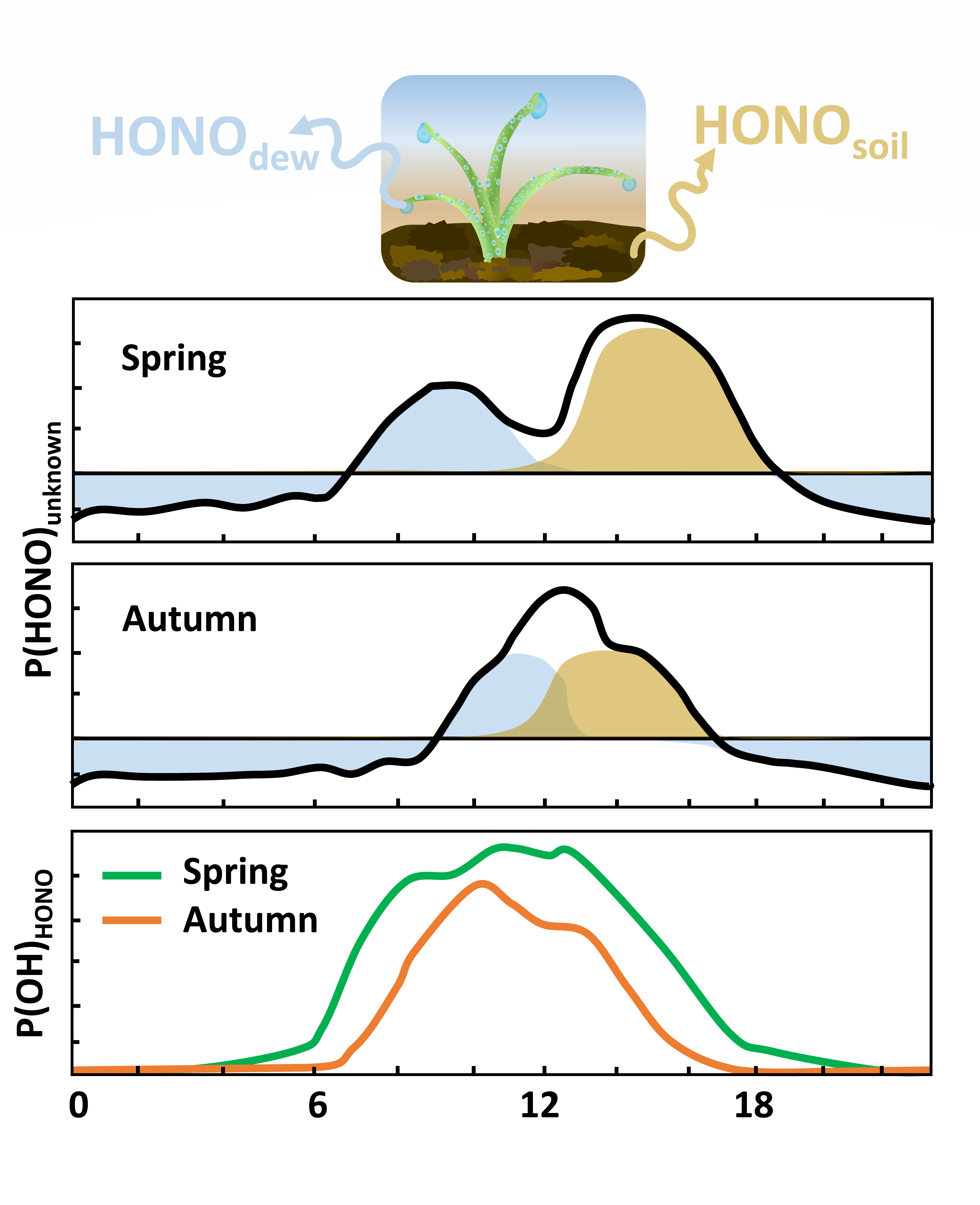
Graphical abstract
Open AccessArticle
Identification and Visualization of Polystyrene Microplastics/Nanoplastics in Flavored Yogurt by Raman Imaging
by
Xin Ling, Jun Cheng, Weirong Yao, He Qian, Dazhi Ding, Zhilong Yu, Yunfei Xie and Fangwei Yang
Toxics 2024, 12(5), 330; https://doi.org/10.3390/toxics12050330 - 30 Apr 2024
Abstract
The contamination of food by microplastics has garnered widespread attention, particularly concerning the health risks associated with small-sized microplastics. However, detecting these smaller microplastics in food poses challenges attributed to the complexity of food matrices and instrumental and method limitations. Here, we employed
[...] Read more.
The contamination of food by microplastics has garnered widespread attention, particularly concerning the health risks associated with small-sized microplastics. However, detecting these smaller microplastics in food poses challenges attributed to the complexity of food matrices and instrumental and method limitations. Here, we employed Raman imaging for visualization and identification of polystyrene particles synthesized in polymerization reactions, ranging from 400 to 2600 nm. We successfully developed a quantitative model of particle size and concentration for polystyrene, exhibiting excellent fit (R2 of 0.9946). We established procedures for spiked flavored yogurt using synthesized polystyrene, providing fresh insights into microplastic extraction efficiency. Recovery rates calculated from models validated the method’s feasibility. In practical applications, the assessment of the size, type, shape, and quantity of microplastics in unspiked flavored yogurt was conducted. The most common polymers found were polystyrene, polypropylene, and polyethylene, with the smallest polystyrene sizes ranging from 1 to 10 μm. Additionally, we conducted exposure assessments of microplastics in branded flavored yogurt. This study established a foundation for developing a universal method to quantify microplastics in food, covering synthesis of standards, method development, validation, and application.
Full article
(This article belongs to the Special Issue Detection and Risk Assessment of Undesirable Chemical Residues in Food)
►▼
Show Figures

Graphical abstract
Open AccessArticle
Independent and Joint Effects of Prenatal Incense-Burning Smoke Exposure and Children’s Early Outdoor Activity on Preschoolers’ Obesity
by
Meimei Chen, Esben Strodl, Weikang Yang, Xiaona Yin, Guomin Wen, Dengli Sun, Danxia Xian, Yafen Zhao and Weiqing Chen
Toxics 2024, 12(5), 329; https://doi.org/10.3390/toxics12050329 - 30 Apr 2024
Abstract
Incense burning is a significant source of indoor air pollution in many Asian regions. There is emerging evidence that maternal prenatal exposure to incense-burning smoke may be a risk factor for childhood obesity. We aimed to extend this new line of research by
[...] Read more.
Incense burning is a significant source of indoor air pollution in many Asian regions. There is emerging evidence that maternal prenatal exposure to incense-burning smoke may be a risk factor for childhood obesity. We aimed to extend this new line of research by investigating the independent and joint effect of incense-burning smoke exposure, and children’s outdoor activity in early life, on preschoolers’ obesity. A total of 69,637 mother–child dyads were recruited from all kindergartens in the Longhua District of Shenzhen, China. Information on sociodemographic characteristics, maternal exposure to incense-burning smoke (IBS) during pregnancy, and frequency and duration of outdoor activity at the age of 1–3 years was collected by a self-administered questionnaire. In addition, the heights and weights of the children were measured by the research team. Logistic regression models and cross-over analyses were conducted to investigate the independent and combined effects of maternal exposure to incense-burning smoke during pregnancy and children’s early outdoor activity on obesity in preschoolers. We found that prenatal exposure to incense-burning smoke increased the risk of the presence of obesity in preschoolers’ (AOR = 1.13, 95% CI = 1.03–1.23). Additionally, lower frequencies (<3 times/week) or shorter durations (<60 min/time) of outdoor activity from the age of 1–3 years were significantly associated with the presence of obesity, with AORs of 1.24 (95% CI =1.18–1.32) and 1.11 (95% CI = 1.05–1.17), respectively. Furthermore, the cross-over analysis showed that prenatal exposure to IBS combined with a lower frequency of early outdoor activity (AOR = 1.47, 95% CI = 1.31–1.66) or a shorter duration of outdoor activity during ages of 1–3 years (AOR = 1.22, 95% CI = 1.07–1.39) increased the risk of obesity in preschoolers. Finally, additive interactions between prenatal exposure to IBS and postnatal outdoor activity on obesity were identified. Our study indicates that maternal exposure to incense-burning smoke during pregnancy and early lower postanal outdoor activity may independently and jointly increase the risk of obesity among preschoolers.
Full article
(This article belongs to the Special Issue Toxicity and Human Health Assessment of Air Pollutants)
Open AccessArticle
Potential Hepatoprotective Effects of Allicin on Carbon Tetrachloride-Induced Acute Liver Injury in Mice by Inhibiting Oxidative Stress, Inflammation, and Apoptosis
by
Qianmei Gong, Xiaoming Wang, Yongshi Liu, Heling Yuan, Zifeng Ge, Yuzhou Li, Jinhu Huang, Yufan Liu, Ming Chen, Wenjun Xiao, Ruiting Liu, Rongmei Shi and Liping Wang
Toxics 2024, 12(5), 328; https://doi.org/10.3390/toxics12050328 - 30 Apr 2024
Abstract
The global burden of liver disease is enormous, which highlights the need for effective hepatoprotective agents. It was reported that allicin exhibits protective effects against a range of diseases. In this study, we further evaluated allicin’s effect and mechanism in acute hepatic injury.
[...] Read more.
The global burden of liver disease is enormous, which highlights the need for effective hepatoprotective agents. It was reported that allicin exhibits protective effects against a range of diseases. In this study, we further evaluated allicin’s effect and mechanism in acute hepatic injury. Liver injury in mice was induced by intraperitoneal injection with 1% CCl4 (10 mL/kg/day). When the first dose was given, CCl4 was given immediately after administration of different doses of allicin (40, 20, and 10 mg/kg/day) as well as compound glycyrrhizin (CGI, 80 mg/kg/day), and then different doses of allicin (40, 20, and 10 mg/kg/day) as well as compound glycyrrhizin (CGI, 80 mg/kg/day) were administrated every 12 h. The animals were dissected 24 h after the first administration. The findings demonstrated a significant inhibition of CCl4-induced acute liver injury following allicin treatment. This inhibition was evidenced by notable reductions in serum levels of transaminases, specifically aspartate transaminase, along with mitigated histological damage to the liver. In this protective process, allicin plays the role of reducing the amounts or the expression levels of proinflammatory cytokines, IL-1β, IL-6. Furthermore, allicin recovered the activities of the antioxidant enzyme catalase (CAT) and reduced the production of malondialdehyde (MDA) in a dose-dependent manner, and also reduced liver Caspase 3, Caspase 8, and BAX to inhibit liver cell apoptosis. Further analysis showed that the administration of allicin inhibited the increased protein levels of Nuclear factor-erythroid 2-related factor 2 (Nrf2) and NAD(P)H:quinone oxidoreductase 1 (NQO1), which is related to inflammation and oxidative stress. The in vitro study of the LPS-induced RAW264.7 inflammatory cell model confirmed that allicin can inhibit important inflammation-related factors and alleviate inflammation. This research firstly clarified that allicin has a significant protective effect on CCl4-induced liver injury via inhibiting the inflammatory response and hepatocyte apoptosis, alleviating oxidative stress associated with the progress of liver damage, highlighting the potential of allicin as a hepatoprotective agent.
Full article
(This article belongs to the Special Issue Research on Veterinary Toxicology)
►▼
Show Figures

Figure 1
Open AccessArticle
Spatial Variation in Mercury Accumulation in Bottlenose Dolphins (Tursiops spp.) in Southeastern U.S.A.
by
Mackenzie L. Griffin, Colleen E. Bryan, Tara M. Cox, Brian C. Balmer, Russell D. Day, Laura Garcia Barcia, Antoinette M. Gorgone, Jeremy J. Kiszka, Jenny A. Litz, Robin M. Perrtree, Teri K. Rowles, Lori H. Schwacke, Randall S. Wells and Eric Zolman
Toxics 2024, 12(5), 327; https://doi.org/10.3390/toxics12050327 - 30 Apr 2024
Abstract
Bottlenose dolphins (Tursiops spp.) inhabit bays, sounds, and estuaries (BSEs) throughout the southeast region of the U.S.A. and are sentinel species for human and ecosystem-level health. Dolphins are vulnerable to the bioaccumulation of contaminants through the coastal food chain because they are
[...] Read more.
Bottlenose dolphins (Tursiops spp.) inhabit bays, sounds, and estuaries (BSEs) throughout the southeast region of the U.S.A. and are sentinel species for human and ecosystem-level health. Dolphins are vulnerable to the bioaccumulation of contaminants through the coastal food chain because they are high-level predators. Currently, there is limited information on the spatial dynamics of mercury accumulation in these dolphins. Total mercury (THg) was measured in dolphin skin from multiple populations across the U.S. Southeast Atlantic and Gulf of Mexico coasts, and the influence of geographic origin, sex, and age class was investigated. Mercury varied significantly among sampling sites and was greatest in dolphins in St. Joseph Bay, Florida Everglades, and Choctawhatchee Bay (14,193 ng/g ± 2196 ng/g, 10,916 ng/g ± 1532 ng/g, and 7333 ng/g ± 1405 ng/g wet mass (wm), respectively) and lowest in dolphins in Charleston and Skidaway River Estuary (509 ng/g ± 32.1 ng/g and 530 ng/g ± 58.4 ng/g wm, respectively). Spatial mercury patterns were consistent regardless of sex or age class. Bottlenose dolphin mercury exposure can effectively represent regional trends and reflect large-scale atmospheric mercury input and local biogeochemical processes. As a sentinel species, the bottlenose dolphin data presented here can direct future studies to evaluate mercury exposure to human residents in St. Joseph Bay, Choctawhatchee Bay, and Florida Coastal Everglades, as well as additional sites with similar geographical, oceanographic, or anthropogenic parameters. These data may also inform state and federal authorities that establish fish consumption advisories to determine if residents in these locales are at heightened risk for mercury toxicity.
Full article
(This article belongs to the Special Issue The Impact of Heavy Metals on Aquatic Ecosystems)
►▼
Show Figures
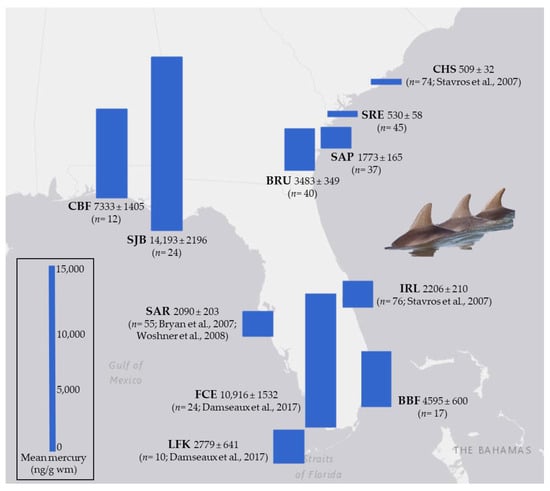
Figure 1
Open AccessArticle
Adapted Sequential Extraction Protocol to Study Mercury Speciation in Gold Mining Tailings: Implications for Environmental Contamination in the Amazon
by
João Pedro Rudrigues de Souza, Jeremie Garnier, Julia Mançano Quintarelli, Myller de Sousa Tonhá, Henrique Llacer Roig, Patrick Seyler and Jurandir Rodrigues de Souza
Toxics 2024, 12(5), 326; https://doi.org/10.3390/toxics12050326 - 30 Apr 2024
Abstract
Artisanal small-scale gold mining (ASGM), an increasingly prevalent activity in South America, generates mercury-contaminated tailings that are often disposed of in the environment, leading to the introduction of mercury into ecosystems and the food web, where it bioaccumulates. Therefore, studying the geochemical processes
[...] Read more.
Artisanal small-scale gold mining (ASGM), an increasingly prevalent activity in South America, generates mercury-contaminated tailings that are often disposed of in the environment, leading to the introduction of mercury into ecosystems and the food web, where it bioaccumulates. Therefore, studying the geochemical processes involved in the desorption and dissolution of mercury in these tailings is essential for critical risk evaluations in the short and long term. For this purpose, sequential extraction procedures (SEPs) can be useful because they help to identify the phases to which Hg is associated, although they also have limitations such as a lack of selectivity and specificity. In this work, we propose a modified four-step SEP: exchangeable mercury (F1), oxidizable mercury (F2), mercury bound to Fe oxides (F3), and strongly bound mercury (F4). To test this adapted sequential extraction method, we evaluated the Hg contamination in mercury-contaminated tailings of the Amazon basin. The results revealed a total mercury concentration of 103 ± 16 mg·kg−1 in the tailings, with a significant portion in F1 (28% of the total), where Hg was bioavailable. The large Hg concentration in F3 (36%) suggested that Fe oxides likely contribute to mercury retention. Together, the SEP results emphasize the urgent need for improved surveillance of gold mining activities and responsible tailings management practices to mitigate environmental contamination and safeguard the health of the Amazon ecosystem.
Full article
(This article belongs to the Section Metals and Radioactive Substances)
►▼
Show Figures
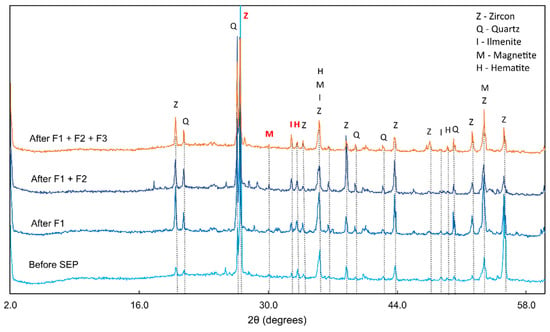
Figure 1
Open AccessArticle
Development of a Fast Method Using Inductively Coupled Plasma Mass Spectrometry Coupled with High-Performance Liquid Chromatography and Exploration of the Reduction Mechanism of Cr(VI) in Foods
by
Ge Song, Honglian Tan, Chuhan Cheng, Peng Li, Xinyang Sun, Yuling Zhou and Yong Fang
Toxics 2024, 12(5), 325; https://doi.org/10.3390/toxics12050325 - 29 Apr 2024
Abstract
Hexavalent chromium (Cr(VI)) is known as the most hazardous species of chromium. Speciation analysis of Cr in foods is of a great significance for assessing its influences on human health. In this study, a fast HPLC-ICP-MS method for the determination of Cr(VI) was
[...] Read more.
Hexavalent chromium (Cr(VI)) is known as the most hazardous species of chromium. Speciation analysis of Cr in foods is of a great significance for assessing its influences on human health. In this study, a fast HPLC-ICP-MS method for the determination of Cr(VI) was developed for determining the content of Cr(VI) and also investigating its transformation in foods. The developed method employs an alkali extraction and weak anion-exchange column separation for distinguishing the Cr species, facilitating accurate Cr(VI) quantification within 1.5 min. This technique was applied to determine the Cr(VI) levels in a range of food products, including yoghurt, milk powder, rice flour, orange juice, green tea, white vinegar, and whole wheat bread. The results showed that no Cr(VI) was detected in these food products. Spiking experiments revealed that the recovery rate of Cr(VI) decreased with the increase in its contact time with food products. A further exploration of Cr(VI) in various food components such as vitamin C, tea polyphenols, whey proteins, gelatin, fructose, and cellulose indicated the conversion of Cr(VI) to organic Cr(III) over a period from 20 min to 60 h. It was found that high temperatures and acidic conditions accelerated the rate of Cr(VI) conversion to organic Cr(III) in the six food components mentioned above. This evidence suggests that natural reducing substances in foods probably prevent the occurrence of Cr(VI).
Full article
(This article belongs to the Special Issue Detection and Risk Assessment of Undesirable Chemical Residues in Food)
►▼
Show Figures
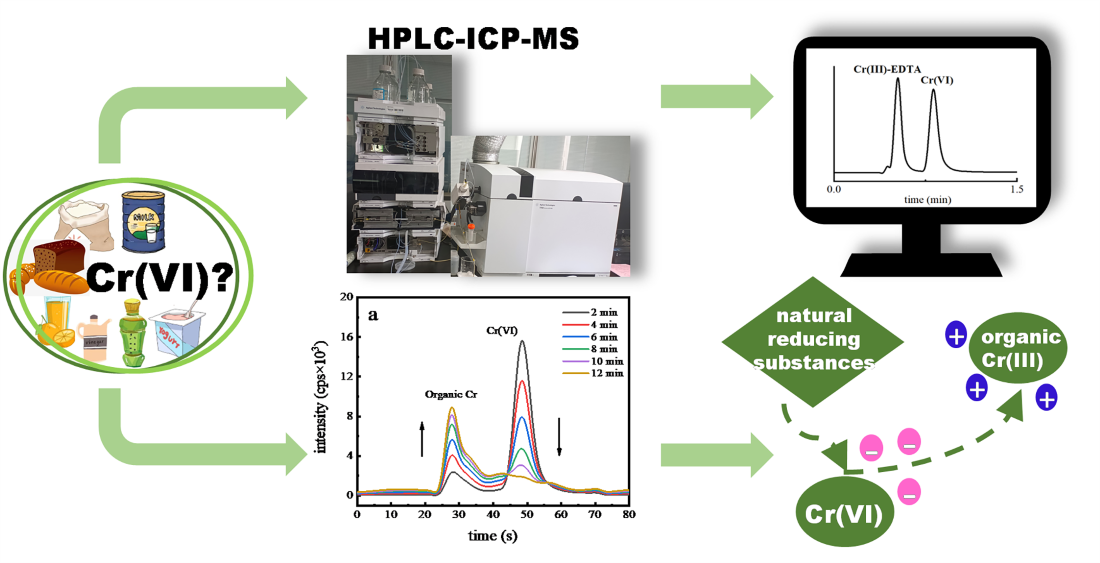
Graphical abstract
Open AccessArticle
Assessing Metal Exposure and Leaching from Discarded Cigarette Butts: Environmental Analysis and Integrated Waste Management Approaches
by
Muhammad Faisal, Zai-Jin You, Noman Ali Buttar, Muhammad Bilal Idrees, Muhammad Naeem, Shoaib Ali, Basharat Ali, Abeer Hashem and Elsayed Fathi Abd_Allah
Toxics 2024, 12(5), 324; https://doi.org/10.3390/toxics12050324 - 29 Apr 2024
Abstract
Cigarette butts, often discarded as litter, are considered a common form of waste, containing a variety of pollutants within this hazardous residue. This study, which was designed to assess the environmental release of certain metals from cigarette butts, investigates a variety of scenarios
[...] Read more.
Cigarette butts, often discarded as litter, are considered a common form of waste, containing a variety of pollutants within this hazardous residue. This study, which was designed to assess the environmental release of certain metals from cigarette butts, investigates a variety of scenarios under varying climatic conditions. Thus, in order to assess the level of metal contamination, samples of cigarette butts were collected in urban areas from seven popular brands in China, smoked artificially, and examined through graphite furnace atomic absorption (GF-AAS). The findings indicated mean concentrations of 1.77 for Cr, 2.88 for Ni, 12.93 for Cu, 24.25 for Zn, and 1.77 µg/g for Pb in the case of newly smoked butts. The emission of each of the metals increases to 8–10% when cigarette butts remain in the environment for an extended period of time. Furthermore, rainfall can accelerate metal leaching, reaching values of 18–20% compared to the controlled scenario. The worst-case scenario releases 2129.31 kg/year of metals into the environment, while the best-case scenario sees a lower release of 844.97 kg/year. The data reflect variations in metal emissions across different scenarios. There was also a strong correlation between cigarette butts in public spaces and cities. This research highlights the need to educate smokers and increase urban maintenance efficiency to reduce this litter and the metals it leaches into the environment.
Full article
(This article belongs to the Special Issue Characterization and Risk Assessment of Heavy Metals in Dust)
►▼
Show Figures
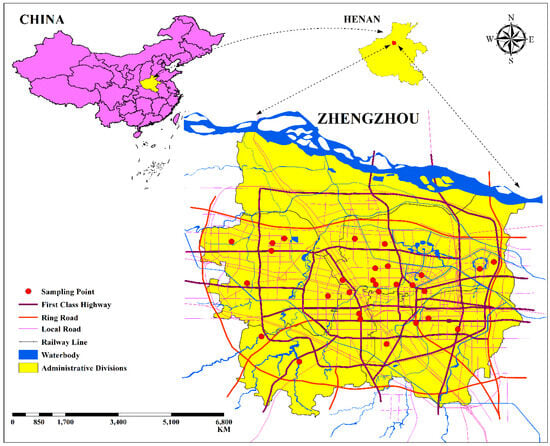
Figure 1
Open AccessArticle
Risks to Human Health from Mercury in Gold Mining in the Coastal Region of Ecuador
by
Carlos Mestanza-Ramón, Samantha Jiménez-Oyola, Juan Cedeño-Laje, Karla Villamar Marazita, Alex Vinicio Gavilanes Montoya, Danny Daniel Castillo Vizuete, Demmy Mora-Silva, Luis Santiago Carrera Almendáriz, Santiago Logroño-Naranjo, Guido Mazón-Fierro, Renato Herrera-Chávez, Giovanni D’Orio and Salvatore Straface
Toxics 2024, 12(5), 323; https://doi.org/10.3390/toxics12050323 - 29 Apr 2024
Abstract
Artisanal and small-scale gold mining (ASGM) plays a crucial role in global gold production. However, the adoption of poor mining practices or the use of mercury (Hg) in gold recovery processes has generated serious environmental contamination events. The focus of this study is
[...] Read more.
Artisanal and small-scale gold mining (ASGM) plays a crucial role in global gold production. However, the adoption of poor mining practices or the use of mercury (Hg) in gold recovery processes has generated serious environmental contamination events. The focus of this study is assessing the concentration of Hg in surface waters within the coastal region of Ecuador. The results are used to conduct a human health risk assessment applying deterministic and probabilistic methods, specifically targeting groups vulnerable to exposure in affected mining environments. Between April and June 2022, 54 water samples were collected from rivers and streams adjacent to mining areas to determine Hg levels. In the health risk assessment, exposure routes through water ingestion and dermal contact were considered for both adults and children, following the model structures outlined by the U.S. Environmental Protection Agency. The results indicate elevated Hg concentrations in two of the five provinces studied, El Oro and Esmeraldas, where at least 88% and 75% of the samples, respectively, exceeded the maximum permissible limit (MPL) set by Ecuadorian regulations for the preservation of aquatic life. Furthermore, in El Oro province, 28% of the samples exceeded the MPL established for drinking water quality. The high concentrations of Hg could be related to illegal mining activity that uses Hg for gold recovery. Regarding the human health risk assessment, risk values above the safe exposure limit were estimated. Children were identified as the most vulnerable receptor. Therefore, there is an urgent need to establish effective regulations that guarantee the protection of river users in potentially contaminated areas. Finally, it is important to continue investigating the contamination caused by human practices in the coastal region.
Full article
(This article belongs to the Special Issue Environmental Exposure to Toxic Chemicals and Human Health II)
►▼
Show Figures
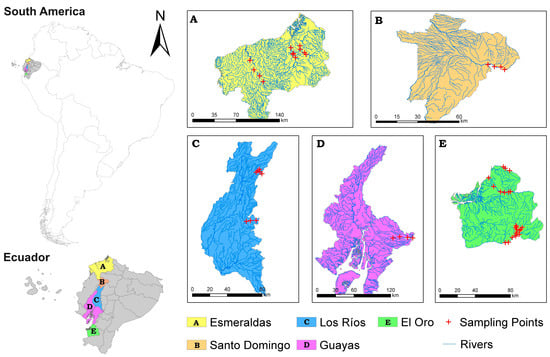
Figure 1
Open AccessArticle
Pollution Characteristics and Risk Assessment of Heavy Metals in the Sediments of the Inflow Rivers of Dianchi Lake, China
by
Liwei He, Guangye Chen, Xinze Wang, Jian Shen, Hongjiao Zhang, Yuanyuan Lin, Yang Shen, Feiyan Lang and Chenglei Gong
Toxics 2024, 12(5), 322; https://doi.org/10.3390/toxics12050322 - 29 Apr 2024
Abstract
To explore the contamination status and identify the source of the heavy metals in the sediments in the major inflow rivers of Dianchi Lake in China, sediment samples were collected and analyzed. Specifically, the distribution, source, water quality, and health risk assessment of
[...] Read more.
To explore the contamination status and identify the source of the heavy metals in the sediments in the major inflow rivers of Dianchi Lake in China, sediment samples were collected and analyzed. Specifically, the distribution, source, water quality, and health risk assessment of the heavy metals were analyzed using correlation analysis (CA), principal component analysis (PCA), the heavy metal contamination factor (Cf), the pollution load index (PLI), and the potential ecological risk index (PERI). Additionally, the chemical fractions were analyzed for mobility characteristics. The results indicate that the average concentration of the heavy metals in the sediment ranked in the descending order of Zn > Cr > Cu > Pb > As > Ni > Cd > Hg, and most of the elements existed in less-mobile forms. The Cfwas in the order of Hg > Zn > Cd > As > Pb > Cr > Ni; the accumulation of Hg, Zn, Cd, and As was obvious. Although the spatial variability of the heavy metal contents was pronounced, the synthetical evaluation index of the PLI and PERI both reached a high pollution level. The PCA and CA results indicate that industrial, transportation, and agricultural emissions were the dominant factors causing heavy metal pollution. These results provide important data for improving water resource management efficiency and heavy metal pollution prevention in Dianchi Lake.
Full article
(This article belongs to the Section Metals and Radioactive Substances)
►▼
Show Figures
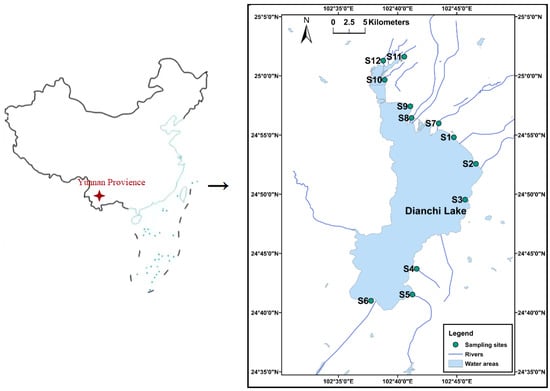
Figure 1
Open AccessArticle
Decadal Trends in Ambient Air Pollutants and Their Association with COPD and Lung Cancer in Upper Northern Thailand: 2013–2022
by
Pachara Sapbamrer, Pheerasak Assavanopakun and Jinjuta Panumasvivat
Toxics 2024, 12(5), 321; https://doi.org/10.3390/toxics12050321 - 28 Apr 2024
Abstract
Air pollution in upper northern Thailand raises health concerns. This study examined trends and associations between air pollutants and respiratory diseases, focusing on COPD and lung cancer during haze (December–May) and non-haze (June–November) seasons in upper northern Thailand from 2013 to 2022. This
[...] Read more.
Air pollution in upper northern Thailand raises health concerns. This study examined trends and associations between air pollutants and respiratory diseases, focusing on COPD and lung cancer during haze (December–May) and non-haze (June–November) seasons in upper northern Thailand from 2013 to 2022. This study utilized data from the Pollution Control Department and Chiang Mai Provincial Public Health. The key air pollutants included PM10, PM2.5, SO2, NO2, CO, and O3. Respiratory disease data included fatality rates for lung cancer and COPD and the re-admission rate for COPD. Results indicated peak air pollutant levels and COPD re-admission rates in March, with PM2.5 concentrations exceeding air quality standards from January to April. During haze periods, COPD fatality and re-admission rates significantly increased (mean difference: 0.43 and 4.23 per 1000-case population, respectively; p < 0.001), while lung cancer fatality rates were higher without statistical significance. Pearson correlation analysis found positive correlations between PM10, PM2.5, O3, and NO2 concentrations and COPD re-admission and fatality rates at 0–1 month lag times, with a declining trend observed at subsequent lag intervals of 2 to 3 months. Overall, this study highlights the predictable pattern of air pollution in the region, correlating with higher COPD fatality and re-admission rates.
Full article
(This article belongs to the Special Issue Air Pollutant Exposure and Respiratory Diseases)
►▼
Show Figures
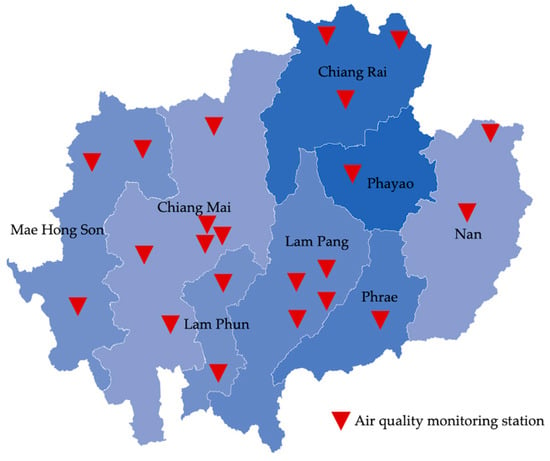
Figure 1
Open AccessReview
Potential Effects of Environmental and Occupational Exposure to Microplastics: An Overview of Air Contamination
by
Priscilla Boccia, Simona Mondellini, Simona Mauro, Miriam Zanellato, Marco Parolini and Elena Sturchio
Toxics 2024, 12(5), 320; https://doi.org/10.3390/toxics12050320 - 28 Apr 2024
Abstract
Microplastics (MPs) are now ubiquitous environmental contaminants that lead to unavoidable human exposure; they have received increasing attention in recent years and have become an emerging area of research. The greatest concern is the negative impacts of MPs on marine, fresh-water, and terrestrial
[...] Read more.
Microplastics (MPs) are now ubiquitous environmental contaminants that lead to unavoidable human exposure; they have received increasing attention in recent years and have become an emerging area of research. The greatest concern is the negative impacts of MPs on marine, fresh-water, and terrestrial ecosystems, as well as human health, to the extent that the World Health Organization (WHO) calls for increased research and standardized methods to assess exposure to MPs. Many countries and international organizations are implementing or proposing legislation in this regard. This review aims to summarize the current state of legislation, indoor and outdoor contamination, and potential human health risk due to exposure to airborne MPs, considering that occupational exposure to MPs is also becoming a growing area of concern. Even though research regarding MPs has continuously increased in the last twenty years, the effects of MPs on human health have been scarcely investigated, and toxicity studies are still limited and not directly comparable, due to the lack of standardized studies in this field.
Full article
(This article belongs to the Special Issue Microplastic Pollution and Impact on Aquatic and Terrestrial Ecosystems)
►▼
Show Figures

Figure 1
Open AccessArticle
Microplastics and 17α Ethinylestradiol: How Do Different Aquatic Invertebrates Respond to This Combination of Contaminants?
by
Caio Rodrigues Nobre, Beatriz Barbosa Moreno, Aline Vecchio Alves, Mayana Karoline Fontes, Bruno Galvão de Campos, Leticia Fernanda da Silva, Luciane Alves Maranho, Luís Felipe de Almeida Duarte, Denis Moledo de Souza Abessa, Rodrigo Brasil Choueri, Paloma Kachel Gusso-Choueri and Camilo Dias Seabra Pereira
Toxics 2024, 12(5), 319; https://doi.org/10.3390/toxics12050319 - 28 Apr 2024
Abstract
The synthetic hormone 17α ethinyl estradiol (EE2) is a molecule widely used in female contraceptives and recognized as a contaminant of attention (Watch List) in the European Union due to its high consumption, endocrine effects and occurrence in aquatic environments. Its main source
[...] Read more.
The synthetic hormone 17α ethinyl estradiol (EE2) is a molecule widely used in female contraceptives and recognized as a contaminant of attention (Watch List) in the European Union due to its high consumption, endocrine effects and occurrence in aquatic environments. Its main source of introduction is domestic sewage where it can be associated with other contaminants such as microplastics (MPs). Due to their characteristics, they can combine with each other and exacerbate their isolated effects on biota. This study evaluated the combined effects of microplastics (MPs) and 17α ethinylestradiol (EE2) on two tropical estuarine invertebrate species: Crassostrea gasar and Ucides cordatus. Polyethylene particles were spiked with EE2 and organisms were exposed to three treatments, categorized into three groups: control group (C), virgin microplastics (MPs), and spiked microplastics with EE2 (MPEs). All treatments were evaluated after 3 and 7 days of exposure. Oysters exhibited changes in phase 2 enzymes and the antioxidant system, oxidative stress in the gills, and reduced lysosomal membrane stability after exposure to MPs and MPEs. Crabs exposed to MPs and MPEs after seven days showed changes in phase 1 enzymes in the gills and changes in phases 1 and 2 enzymes in the hepatopancreas, such as disturbed cellular health. The combined effects of microplastics and EE2 increased the toxicity experienced by organisms, which may trigger effects at higher levels of biological organization, leading to ecological disturbances in tropical coastal ecosystems.
Full article
(This article belongs to the Special Issue Microplastic Pollution and Impact on Aquatic and Terrestrial Ecosystems)
►▼
Show Figures
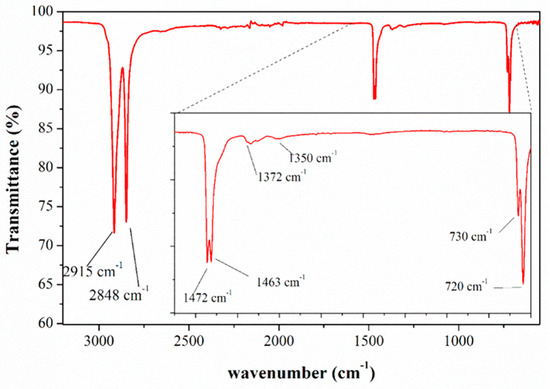
Figure 1

Journal Menu
► ▼ Journal Menu-
- Toxics Home
- Aims & Scope
- Editorial Board
- Reviewer Board
- Topical Advisory Panel
- Instructions for Authors
- Special Issues
- Topics
- Sections & Collections
- Article Processing Charge
- Indexing & Archiving
- Editor’s Choice Articles
- Most Cited & Viewed
- Journal Statistics
- Journal History
- Journal Awards
- Editorial Office
Journal Browser
► ▼ Journal BrowserHighly Accessed Articles
Latest Books
E-Mail Alert
News
Topics
Topic in
Materials, Minerals, Processes, Sustainability, Toxics, Water
Removal of Hazardous Substances from Water Resources
Topic Editors: Gujie Qian, Yan Zhou, Weifeng ChenDeadline: 20 May 2024
Topic in
Diversity, Environments, JMSE, Toxics, Water
Coastal Macro-, Meso-, and Microplastic Pollution: Effects on the Health of Humans and Ecosystems
Topic Editors: Alba Ardura Gutiérrez, Sara Fernandez FernandezDeadline: 30 May 2024
Topic in
Energies, Membranes, Minerals, Toxics, Water
Renewable Energies for Water Treatment and Reuse in Mining Industries
Topic Editors: Sergio Santoro, Francesco Chidichimo, Barbara Ruffino, Lourdes García-RodríguezDeadline: 30 June 2024
Topic in
IJERPH, Microplastics, Sustainability, Toxics, Water
Microplastics Pollution
Topic Editors: Grigorios L. Kyriakopoulos, Vassilis J. Inglezakis, Antonis A. Zorpas, María Rocío Rodríguez BarrosoDeadline: 31 August 2024

Conferences
Special Issues
Special Issue in
Toxics
Spotlight on the Ecotoxicological Impacts of Plastic Pollution
Guest Editors: Mariana Capparelli, Denis AbessaDeadline: 16 May 2024
Special Issue in
Toxics
Environmental Justice: Disproportionate Exposures to Toxic Contaminants
Guest Editors: James M. Harrington, Rios-Colon LeslimarDeadline: 31 May 2024
Special Issue in
Toxics
Analysis, Exposures, and Health Risks of Indoor and Outdoor Air Pollution
Guest Editors: Besis Athanasios, Cécile VignalDeadline: 21 June 2024
Special Issue in
Toxics
Environmental Pollutants, Neurocognitive Disorders and Other Health Outcomes in Autochthones Populations Worldwide
Guest Editors: Paulo Cesar Basta, Ana Claudia Santiago De VasconcellosDeadline: 30 June 2024
Topical Collections
Topical Collection in
Toxics
Exposure and Effects of Environmental Pollution on Vulnerable Populations
Collection Editors: Matteo Vitali, Carmela Protano, Arianna Antonucci
Topical Collection in
Toxics
Xenobiotics in Developmental Neurotoxicity
Collection Editor: David R. Wallace





